Baking pasta creates a crispy, layered texture ideal for casseroles like lasagna, while boiling ensures a tender, evenly cooked consistency perfect for dishes like spaghetti. Baking allows flavors to meld and ingredients to develop a rich, browned crust, whereas boiling preserves the pasta's softness and ability to absorb sauces. Choosing between baking and boiling depends on the desired texture and recipe outcome, with baking offering a hearty finish and boiling providing a smooth, classic pasta experience.
Table of Comparison
| Method | Baking Pasta | Boiling Pasta |
|---|---|---|
| Cooking Process | Oven heat, combines pasta with sauce and cheese | Submerged in boiling water until al dente |
| Texture | Creamy, firm edges, crispy topping | Soft, tender, evenly cooked |
| Flavor | Rich, melded flavors from baking ingredients | Neutral, highlights sauce added after boiling |
| Time | 25-40 minutes including baking time | 7-12 minutes boiling time |
| Energy Use | Higher energy due to oven | Lower energy, stove top only |
| Best For | Casseroles, baked pasta dishes, layered meals | Traditional pasta dishes, quick meals |
Introduction to Finishing Pasta: Baking vs Boiling
Finishing pasta involves either boiling or baking, methods that significantly affect texture and flavor. Boiling maintains a softer, more traditional pasta consistency by quickly cooking pasta in water, preserving moisture and elasticity. Baking, often used in casseroles like lasagna, creates a firmer texture with a browned, crispy top that enhances depth and richness of the dish.
Key Differences Between Baking and Boiling Pasta
Baking pasta results in a crispy texture and caramelized flavor, ideal for casseroles and layered dishes like lasagna, while boiling pasta produces a soft, tender consistency suited for traditional sauced dishes. Baking allows the pasta to absorb flavors from cheese, sauce, and other ingredients during cooking, whereas boiling purely softens the pasta before mixing it with sauces. The key difference lies in texture and flavor development, with baking providing a more complex, browned finish and boiling maintaining a delicate, moist pasta.
Flavor Development: Baking vs Boiling Pasta
Baking pasta enhances flavor development by allowing Maillard reactions to occur, creating a richer, caramelized taste and a slightly crispy texture. Boiling pasta preserves the natural starches and yields a tender, consistent bite but may lack the depth of flavor found in baked dishes like lasagna or baked ziti. Choosing between baking and boiling affects the final taste profile, with baking offering more complex, robust flavors.
Texture Outcomes: What to Expect from Each Method
Baking pasta results in a firmer, chewier texture with a golden, crispy top layer, ideal for casseroles and layered dishes that require structural integrity. Boiling pasta produces a softer, more uniform texture with a tender bite, allowing the pasta to absorb sauces evenly and maintain moisture throughout. Texture outcomes vary as baking enhances crust formation and density, while boiling emphasizes pliability and smoothness in the pasta strands.
Nutritional Impacts of Baking Versus Boiling Pasta
Baking pasta retains more nutrients such as B vitamins and minerals compared to boiling, where water-soluble vitamins like folate and niacin leach into the water. The Maillard reaction during baking can enhance flavor without significant nutrient loss, whereas boiling pasta dilutes protein and fiber content due to water absorption and nutrient runoff. Baking also reduces glycemic index slightly by creating a firmer texture that slows starch digestion.
Time and Convenience: Which Method is Faster?
Boiling pasta typically takes 8 to 12 minutes depending on the type and thickness, offering a quick and traditional method for cooking. Baking requires additional time, ranging from 20 to 40 minutes, as it involves both cooking and melting ingredients like cheese or sauce simultaneously. For convenience and speed, boiling pasta is faster, while baking provides a hands-off approach that combines cooking with flavor development.
Best Sauce Pairings for Baked and Boiled Pasta
Baked pasta, such as lasagna or baked ziti, pairs excellently with rich, hearty tomato-based sauces and creamy bechamel, enhancing its layered texture and caramelized top. Boiled pasta is best complemented by lighter sauces like olive oil and garlic, fresh pesto, or simple marinara, which cling well to its smoother surface for balanced flavor. Cream-based sauces also work well with boiled pasta, providing a silky coating without overwhelming the delicate texture.
Traditional Dishes: When to Bake or Boil Pasta
Traditional dishes like lasagna and baked ziti benefit from baking, which allows layers of pasta, sauce, and cheese to meld while creating a golden, bubbly top crust. Boiling is essential for classic dishes such as spaghetti and fettuccine Alfredo, ensuring perfectly tender pasta that absorbs sauce evenly. Understanding when to bake or boil pasta preserves the authentic texture and flavor profiles distinctive to each regional recipe.
Common Mistakes in Baking and Boiling Pasta
Overcooking pasta during boiling often results in mushy texture and loss of nutrients, while undercooking leaves it too firm to absorb sauces properly. Baking pasta commonly causes dryness or uneven cooking if not covered or stirred, diminishing flavor and texture quality. Avoiding excessive boiling time and ensuring proper baking temperature are critical to preserving pasta's optimal firmness and taste.
Choosing the Right Pasta Finish: Baking or Boiling?
Choosing the right pasta finish depends on the desired texture and flavor profile, with boiling preserving a tender, al dente bite while baking creates a crispy, golden crust that enhances depth. Boiling pasta in salted water around 100degC ensures even cooking and softens the noodles, making it ideal for sauced dishes that require moisture retention. Baking pasta in a preheated oven at 180-200degC for about 20-30 minutes adds caramelization and blends ingredients like cheese and sauce, perfect for casseroles and baked pasta recipes.
Baking vs boiling for finishing pasta Infographic

 cookingdif.com
cookingdif.com